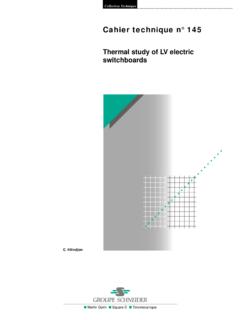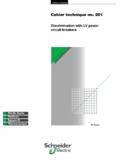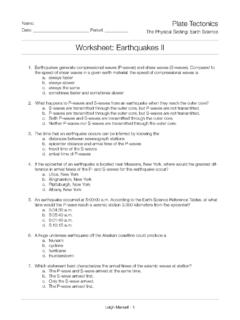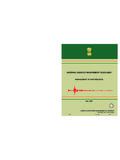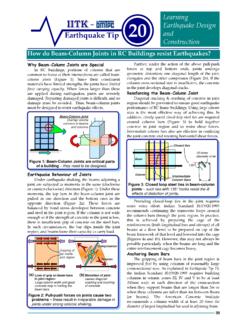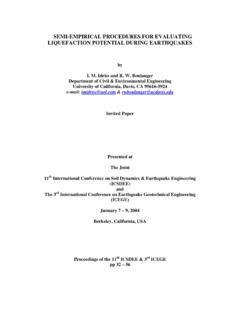Transcription of Earthquakes and electrical equipment - studiecd.dk
1 N 180earthquakesand electricalequipmentE/CT180 (e) first issued, April 1997 Eric MELMOUXG raduated in mechanicalengineering from the INSA School,Lyon in 1981, and obtained a DEA(equivalent to 1st year of Phd) in vibrations the same ten years spent with acompany which specialises in soundand vibrations, he joinedMerlin is, at present, head of the shocks and vibrations group atSchneider Technique Merlin Gerin n 180 / at ground level, vertically above the appropriationexcitation frequency corresponds with resonance frequency of the or seismic focusposition of the earthquake in the earth s the force of the earthquake in terms of the effects produced (MERCALLI scale).LOVE Wavescorrespond to the horizontal component of the surface the force of the earthquake in terms energy released at the seismic focus(RICHTER scale).
2 Meshingaction whereby a complex structure is broken down into its beam gantrys - plates Historical earthquake Likelihood for a shapeoscillating deformation adopted by an elastic structure during excitation on one of itsresonance which consists in establishing the appropriate withstand capabilities forequipment with required or normal Wavescorrespond to the vertical component of the surface Spectrumdevice which enables a characterization of the earthquake to be effectuated in terms ofits effects on a simple Activityviolent movement of tectonic plates which produces an DOF mechanical systemsingle degree of freedom structure characterized by mass, spring and appropriationexcitation forces apply pressure on the antinodes of the modal Shutdown earthquake (MHEL plus one degree on the MERCALLI scale).
3 Strong part of response spectrumcorresponds to the frequencies which cause the structure to amplify of ground acceleration during the Period Acceleration ZPA partcorresponds, on a response spectrum, to the frequencies which cause the structure totrace ground accelerations without amplification of Technique Merlin Gerin n 180 / and electrical equipmentcontents1. EarthquakesCauses - locationp. 4 Propagation of seismic wavesp. 4 Characteristics of vibrationsp. 4generated at ground levelIntensity and magnitudep. 4 Seism characterizationp. 6 Defining the seismic severityp. 8of a siteReading the response spectrum p. 9applicable to a piece of equipment2. Dynamic behaviour of structuresBrief summary of single degreep.
4 12of freedom oscillatorElastic structures (with Np. 12degrees of freedom)3. equipment designDefining objectivesp. 16 Design principlesp. 16 Simulation by analysis atp. 18design stage4. Qualification by simulation or testIntroductionp. 20 Combined qualificationp. 20(numerical analysis andexperimental tuning)Qualification by real size p. 21tests preceded by numericalanalysisQualification by testp. 225. Conclusionp. 256. Bibliographyp. 26In all countries there is either a zone ofsignificant seismic activity orinstallations which require high securityin order to operate ( nuclear powerstations, which generally have lowseismic activity). In both cases theelectrical and control and monitoringequipment must assure their safetyfunctions technical paper aims to facilitatedialogue between operators briefly summarizing theearthquake phenomena and the wayin which they are specified, the authorpresents the theoretic approachrequired for seismic withstandcapabilities to be taken into account atthe design design and qualification are,today, increasingly requiring numericalanalysis and, as a result.
5 Powerfulscientific and technical data Technique Merlin Gerin n 180 / earthquakescauses - locationThe majority of Earthquakes occur onthe fault lines which demarcate thetectonic plates from the earth s accumulates when the platesslowly shift away from each other. Thesudden release of distorting energywhich has thus accumulated inside theearth s crust, or in the underlying layercalled the mantle, provokes a localagitation. Some of this energy is thentransformed into seismic waves at thesurface of the is the creation of a fault line, or morefrequently the slide along an existingfault line, which constitutes thegenerating mechanism of anearthquake. The place where it occursis called the seismic focus or thehypocenter and the projection fromthis point to the ground is called theepicenter (see fig.)
6 1).The depth of the hypocenter variesgreatly: from a few kilometres to upto of seismicwavesEarthquakes propagate in waveswhich, taking the heterogeneity of theground into account, provoke acomplex vibratory movement at thesurface which is difficult to predict for agiven distinction is made between twotypes of wave: bulk waves and wavesThey originate at the seismic focus andpropagate inside the earth s mantle intwo different forms:c longitudinal waves characterised byalternating compressions and dilationswhich propagate at a speedof 7 to 8 km/s,c transversal waves characterised by aplane distortion perpendicular to thedirection of the propagation, whichprovoke shear and propagate at aspeed of 4 to 5 km/s (see fig.
7 2).Remark:It is the difference in speed betweenthe longitudinal and transversal wavesand recordings taken from severalseismographs, which enables an earth-quake s seismic focus to be wavesThese are generated by the bulk waveswhich reach the surface and propagateat a speed of to 5 distinction is made between:c RAYLEIGH waves which cause theground points to describe ellipses in thevertical plane; they engendercompression and shear in the ground,c LOVE waves which cause the groundpoints to shift at a tangent to thesurface, perpendicular to thepropagation direction; they engendershear only (see fig. 2).characteristics ofvibrations generated atground levelIn reality things are far more complex;the propagation of a seismic wave in aheterogeneous environment provokes acomplex system of refracted andreflected waves for each discontinuity,so that the seismic movement iscompletely random at ground , vibratory movements broughtabout at ground level by earthquakesdo produce common characteristics,and a certain number of parameters aregenerally employed to describe of random vibrationsprovoked at ground level by anearthquake:c directionThe movement is made up ofsimultaneous independent vertical andhorizontal components.
8 C durationIt is usually between 15 and 30 s (anintense earthquake can last between60 and 120 seconds).c frequencyBroad band random movementproduces preponderant energybetween 1 and 35 Hz, and provokesthe most destructive effects atbetween 1 and 10 level of accelerationThere is no correlation between thewaves observed in the two differentdirections: at any given moment theamplitudes and frequencies ground acceleration isgenerally lower than g(exceptionally higher than 1g,or 10 m/s2).Vertical acceleration has a loweramplitude. Observations show that therelationship between the maximumvertical and horizontal amplitudes is inthe order of 23 (for frequencies higherthan Hz).intensity and magnitudeIntensityThe scale of an earthquake is generallymeasured in terms of its intensity at theobservation site.
9 This subjectiveevaluation is established in terms of theeffects felt by the population and thedamage intensity scales have beendefined, which class the seismic effectsin order of increasing size, with the helpof some conventional descriptions:c the MERCALLI scale describescommonly observed effects on theenvironment, buildings and man afteran earthquake ,c the MSK scale (or modified Mercalliscale), more precise than the original,includes an evaluation of the damage,Cahier Technique Merlin Gerin n 180 / : geosismic vocabulary and characteristic : seismic bulk and surface type of building and percentage ofbuildings estimations are useful forassessing the size of Earthquakes ifthere are no time-histories or spectraavailable.
10 They do not enable theseismic load of a site to be method of determining thescale of an earthquake is to establishits magnitude, the intrinsiccharacteristic of an earthquake whichmeasures the total energy , defined in1935 byRICHTER, and the scale which ensued,are used is, in practice, determinedaccording to ground movementrecordings taken at a number ofobservation points at various distancesfrom the these observations seismologistscalculate the energy E (expressed inergs) of the earthquake , from which themagnitude M is simplified empirical equation:log E = + M + M2 givesan approximate, but rapid / maximum groundacceleration / seismic zonecorrelationThe table in figure 3 (see overleaf)establishes a correlation between thevarious subjective levels of intensity inthe modified MERCALLI scale and themaximum ground acceleration levelresponsible for the damage table also indicates the type ofseismic activity zones prone to suchseismic intensity (see fig.)


